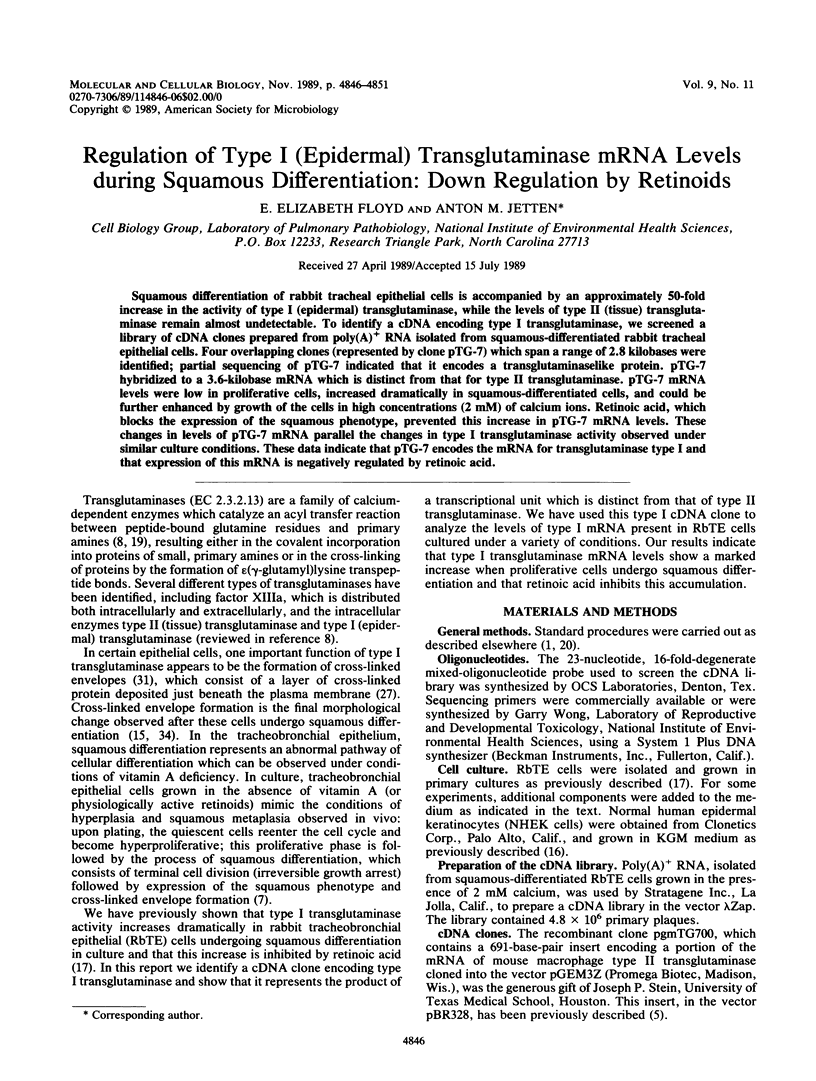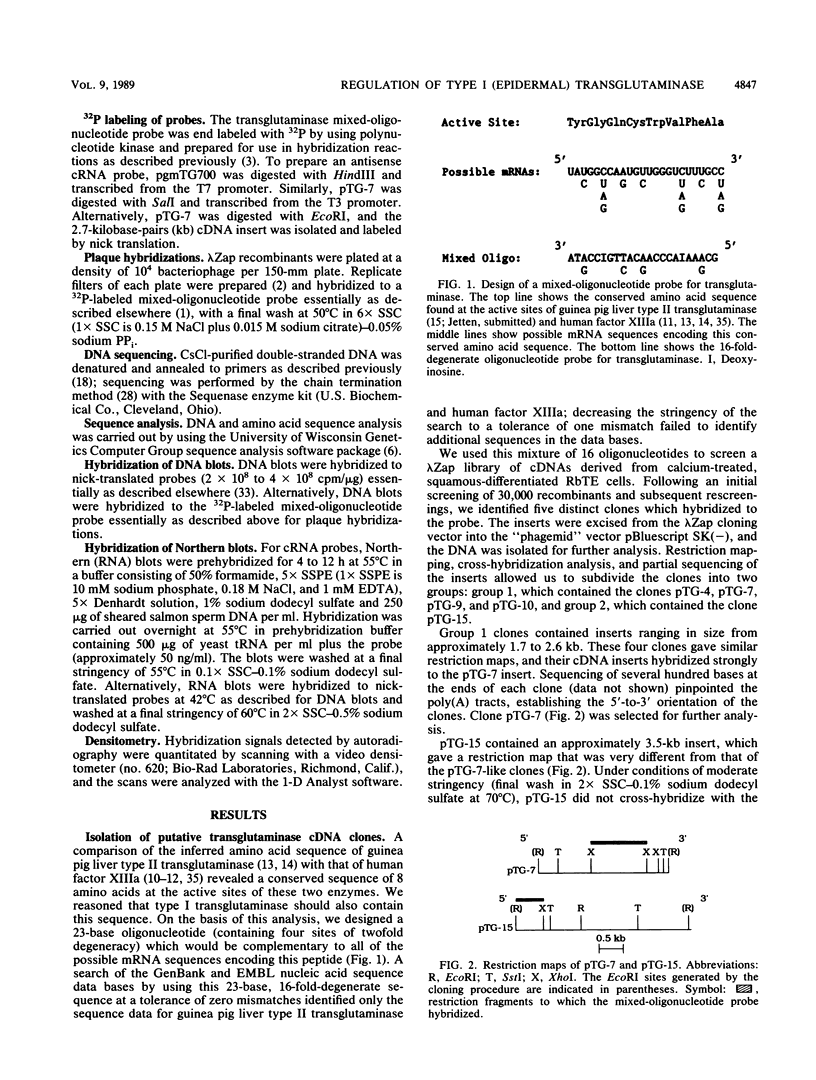Abstract
Squamous differentiation of rabbit tracheal epithelial cells is accompanied by an approximately 50-fold increase in the activity of type I (epidermal) transglutaminase, while the levels of type II (tissue) transglutaminase remain almost undetectable. To identify a cDNA encoding type I transglutaminase, we screened a library of cDNA clones prepared from poly(A)+ RNA isolated from squamous-differentiated rabbit tracheal epithelial cells. Four overlapping clones (represented by clone pTG-7) which span a range of 2.8 kilobases were identified; partial sequencing of pTG-7 indicated that it encodes a transglutaminaselike protein. pTG-7 hybridized to a 3.6-kilobase mRNA which is distinct from that for type II transglutaminase. pTG-7 mRNA levels were low in proliferative cells, increased dramatically in squamous-differentiated cells, and could be further enhanced by growth of the cells in high concentrations (2 mM) of calcium ions. Retinoic acid, which blocks the expression of the squamous phenotype, prevented this increase in pTG-7 mRNA levels. These changes in levels of pTG-7 mRNA parallel the changes in type I transglutaminase activity observed under similar culture conditions. These data indicate that pTG-7 encodes the mRNA for transglutaminase type I and that expression of this mRNA is negatively regulated by retinoic acid.
Full text
PDF





Images in this article
Selected References
These references are in PubMed. This may not be the complete list of references from this article.
- Benton W. D., Davis R. W. Screening lambdagt recombinant clones by hybridization to single plaques in situ. Science. 1977 Apr 8;196(4286):180–182. doi: 10.1126/science.322279. [DOI] [PubMed] [Google Scholar]
- Brand N., Petkovich M., Krust A., Chambon P., de Thé H., Marchio A., Tiollais P., Dejean A. Identification of a second human retinoic acid receptor. Nature. 1988 Apr 28;332(6167):850–853. doi: 10.1038/332850a0. [DOI] [PubMed] [Google Scholar]
- Chiocca E. A., Davies P. J., Stein J. P. The molecular basis of retinoic acid action. Transcriptional regulation of tissue transglutaminase gene expression in macrophages. J Biol Chem. 1988 Aug 15;263(23):11584–11589. [PubMed] [Google Scholar]
- Devereux J., Haeberli P., Smithies O. A comprehensive set of sequence analysis programs for the VAX. Nucleic Acids Res. 1984 Jan 11;12(1 Pt 1):387–395. doi: 10.1093/nar/12.1part1.387. [DOI] [PMC free article] [PubMed] [Google Scholar]
- Floyd E. E., Jetten A. M. Retinoids, growth factors, and the tracheobronchial epithelium. Lab Invest. 1988 Jul;59(1):1–4. [PubMed] [Google Scholar]
- Folk J. E. Transglutaminases. Annu Rev Biochem. 1980;49:517–531. doi: 10.1146/annurev.bi.49.070180.002505. [DOI] [PubMed] [Google Scholar]
- Giguere V., Ong E. S., Segui P., Evans R. M. Identification of a receptor for the morphogen retinoic acid. Nature. 1987 Dec 17;330(6149):624–629. doi: 10.1038/330624a0. [DOI] [PubMed] [Google Scholar]
- Grundmann U., Amann E., Zettlmeissl G., Küpper H. A. Characterization of cDNA coding for human factor XIIIa. Proc Natl Acad Sci U S A. 1986 Nov;83(21):8024–8028. doi: 10.1073/pnas.83.21.8024. [DOI] [PMC free article] [PubMed] [Google Scholar]
- Ichinose A., Davie E. W. Characterization of the gene for the a subunit of human factor XIII (plasma transglutaminase), a blood coagulation factor. Proc Natl Acad Sci U S A. 1988 Aug;85(16):5829–5833. doi: 10.1073/pnas.85.16.5829. [DOI] [PMC free article] [PubMed] [Google Scholar]
- Ichinose A., Hendrickson L. E., Fujikawa K., Davie E. W. Amino acid sequence of the a subunit of human factor XIII. Biochemistry. 1986 Nov 4;25(22):6900–6906. doi: 10.1021/bi00370a025. [DOI] [PubMed] [Google Scholar]
- Ikura K., Nasu T., Yokota H., Tsuchiya Y., Sasaki R., Chiba H. Amino acid sequence of guinea pig liver transglutaminase from its cDNA sequence. Biochemistry. 1988 Apr 19;27(8):2898–2905. doi: 10.1021/bi00408a035. [DOI] [PubMed] [Google Scholar]
- Jetten A. M., George M. A., Nervi C., Boone L. R., Rearick J. I. Increased cholesterol sulfate and cholesterol sulfotransferase activity in relation to the multi-step process of differentiation in human epidermal keratinocytes. J Invest Dermatol. 1989 Feb;92(2):203–209. doi: 10.1111/1523-1747.ep12276731. [DOI] [PubMed] [Google Scholar]
- Jetten A. M., George M. A., Smits H. L., Vollberg T. M. Keratin 13 expression is linked to squamous differentiation in rabbit tracheal epithelial cells and down-regulated by retinoic acid. Exp Cell Res. 1989 Jun;182(2):622–634. doi: 10.1016/0014-4827(89)90264-4. [DOI] [PubMed] [Google Scholar]
- Jetten A. M. Multistep process of squamous differentiation in tracheobronchial epithelial cells in vitro: analogy with epidermal differentiation. Environ Health Perspect. 1989 Mar;80:149–160. doi: 10.1289/ehp.8980149. [DOI] [PMC free article] [PubMed] [Google Scholar]
- Jetten A. M., Shirley J. E. Characterization of transglutaminase activity in rabbit tracheal epithelial cells. Regulation by retinoids. J Biol Chem. 1986 Nov 15;261(32):15097–15101. [PubMed] [Google Scholar]
- Kraft R., Tardiff J., Krauter K. S., Leinwand L. A. Using mini-prep plasmid DNA for sequencing double stranded templates with Sequenase. Biotechniques. 1988 Jun;6(6):544-6, 549. [PubMed] [Google Scholar]
- Lorand L., Conrad S. M. Transglutaminases. Mol Cell Biochem. 1984;58(1-2):9–35. doi: 10.1007/BF00240602. [DOI] [PubMed] [Google Scholar]
- Martinet N., Kim H. C., Girard J. E., Nigra T. P., Strong D. H., Chung S. I., Folk J. E. Epidermal and hair follicle transglutaminases. Partial characterization of soluble enzymes in newborn mouse skin. J Biol Chem. 1988 Mar 25;263(9):4236–4241. [PubMed] [Google Scholar]
- Murtaugh M. P., Mehta K., Johnson J., Myers M., Juliano R. L., Davies P. J. Induction of tissue transglutaminase in mouse peritoneal macrophages. J Biol Chem. 1983 Sep 25;258(18):11074–11081. [PubMed] [Google Scholar]
- Nervi C., Grippo J. F., Sherman M. I., George M. D., Jetten A. M. Identification and characterization of nuclear retinoic acid-binding activity in human myeloblastic leukemia HL-60 cells. Proc Natl Acad Sci U S A. 1989 Aug;86(15):5854–5858. doi: 10.1073/pnas.86.15.5854. [DOI] [PMC free article] [PubMed] [Google Scholar]
- Petkovich M., Brand N. J., Krust A., Chambon P. A human retinoic acid receptor which belongs to the family of nuclear receptors. Nature. 1987 Dec 3;330(6147):444–450. doi: 10.1038/330444a0. [DOI] [PubMed] [Google Scholar]
- Rearick J. I., Albro P. W., Jetten A. M. Increase in cholesterol sulfotransferase activity during in vitro squamous differentiation of rabbit tracheal epithelial cells and its inhibition by retinoic acid. J Biol Chem. 1987 Sep 25;262(27):13069–13074. [PubMed] [Google Scholar]
- Rearick J. I., Hesterberg T. W., Jetten A. M. Human bronchial epithelial cells synthesize cholesterol sulfate during squamous differentiation in vitro. J Cell Physiol. 1987 Dec;133(3):573–578. doi: 10.1002/jcp.1041330320. [DOI] [PubMed] [Google Scholar]
- Rearick J. I., Jetten A. M. Accumulation of cholesterol 3-sulfate during in vitro squamous differentiation of rabbit tracheal epithelial cells and its regulation by retinoids. J Biol Chem. 1986 Oct 25;261(30):13898–13904. [PubMed] [Google Scholar]
- Rice R. H., Green H. The cornified envelope of terminally differentiated human epidermal keratinocytes consists of cross-linked protein. Cell. 1977 Jun;11(2):417–422. doi: 10.1016/0092-8674(77)90059-9. [DOI] [PubMed] [Google Scholar]
- Sanger F., Nicklen S., Coulson A. R. DNA sequencing with chain-terminating inhibitors. Proc Natl Acad Sci U S A. 1977 Dec;74(12):5463–5467. doi: 10.1073/pnas.74.12.5463. [DOI] [PMC free article] [PubMed] [Google Scholar]
- Schmidt R., Michel S., Shroot B., Reichert U. Transglutaminases in normal and transformed human keratinocytes in culture. J Invest Dermatol. 1988 Apr;90(4):475–479. doi: 10.1111/1523-1747.ep12460936. [DOI] [PubMed] [Google Scholar]
- Schmidt R., Reichert U., Michel S., Shroot B., Bouclier M. Plasma membrane transglutaminase and cornified envelope competence in cultured human keratinocytes. FEBS Lett. 1985 Jul 8;186(2):201–204. doi: 10.1016/0014-5793(85)80708-0. [DOI] [PubMed] [Google Scholar]
- Simon M., Green H. Participation of membrane-associated proteins in the formation of the cross-linked envelope of the keratinocyte. Cell. 1984 Apr;36(4):827–834. doi: 10.1016/0092-8674(84)90032-1. [DOI] [PubMed] [Google Scholar]
- Slife C. W., Morris G. S., Snedeker S. W. Solubilization and properties of the liver plasma membrane transglutaminase. Arch Biochem Biophys. 1987 Aug 15;257(1):39–47. doi: 10.1016/0003-9861(87)90540-6. [DOI] [PubMed] [Google Scholar]
- Smits H. L., Floyd E. E., Jetten A. M. Molecular cloning of gene sequences regulated during squamous differentiation of tracheal epithelial cells and controlled by retinoic acid. Mol Cell Biol. 1987 Nov;7(11):4017–4023. doi: 10.1128/mcb.7.11.4017. [DOI] [PMC free article] [PubMed] [Google Scholar]
- Sun T. T., Green H. Differentiation of the epidermal keratinocyte in cell culture: formation of the cornified envelope. Cell. 1976 Dec;9(4 Pt 1):511–521. doi: 10.1016/0092-8674(76)90033-7. [DOI] [PubMed] [Google Scholar]
- Takahashi N., Takahashi Y., Putnam F. W. Primary structure of blood coagulation factor XIIIa (fibrinoligase, transglutaminase) from human placenta. Proc Natl Acad Sci U S A. 1986 Nov;83(21):8019–8023. doi: 10.1073/pnas.83.21.8019. [DOI] [PMC free article] [PubMed] [Google Scholar]
- Thacher S. M., Rice R. H. Keratinocyte-specific transglutaminase of cultured human epidermal cells: relation to cross-linked envelope formation and terminal differentiation. Cell. 1985 Mar;40(3):685–695. doi: 10.1016/0092-8674(85)90217-x. [DOI] [PubMed] [Google Scholar]




